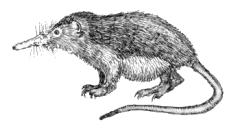Cuban Solenodon (Solenodon cubanus) [Photo] Solenodon cubanus (Atopogale cubana), pl:Almik kuba??ski, en:Cuban Solenodon. By Monika Betley
The Cuban Solenodon (known as the Almiqui in Cuba) (Atopogale cubana, Solenodon cubanus) is an insectivore native to Cuba. It belongs to the family Solenodontidae along with a similar species, the Haitian Solenodon (Solenodon paradoxus). The solenodon is unusual among mammals in that its saliva is venomous.
Rediscovery
Since its discovery in 1861 by the German naturalist Wilhelm Peters, only 36 had ever been caught. By 1970, some thought that the Cuban solenodon had become extinct, since no specimens had been found since 1890. On June 2, 1970, the Cuban Solenodon was classified as endangered. However, three were captured in 1974 and 1975, and subsequent surveys showed that it still occurred in many places in central and western Oriente Province, at the eastern end of Cuba. However, it is rare everywhere. Prior to 2003, the most recent sighting was in 1999 mainly because it is a nocturnal burrower, living underground, and thus is very rarely seen. The Cuban Solenodon that was found in 2003, named Alejandrito, brought the number ever caught to 37. He weighed 24 ounces and was healthy. He was released back into the wild after two days of scientific study were completed.
Appearance
With small eyes, and dark brown to black hair, it is sometimes compared to a shrew, although it most closely resembles members of the family Tenrecidae, of Madagascar. It is 16-22 inches (40-55 centimeters) long from nose to tail and resembles a large brown rat with an extremely elongated snout and a long, naked, scaly tail.
Status
While it is not yet extinct, it is still an endangered species, in part because it only breeds a single litter of one to three in a year, and, like the Agouta, because of predation by species that were introduced by humans.
External links
http://encarta.msn.com/media_461532609/Cuban_Solenodon.html
